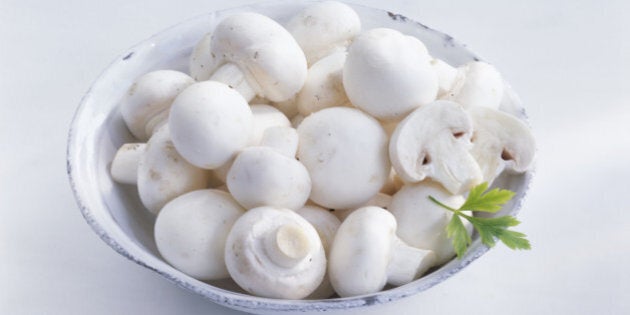
How can such a common mushroom harbor so many anti-cancer qualities?
Credit its lectins, for starters-Agaricus bisporus lectin, or ABL for short, named for the button species, Agaricus bisporus, better known to you as white, baby brown or crimini, and adult portobellos.
Remember my peanut blog posted here more than a year ago? Lectins are proteins that bind to carbohydrates; and after eating peanuts, their PNA lectins get into your blood, bind to cancer cells that have spread there and then help those naughty cells grow and spread, says lectin researcher Dr. Lugang Yu. The preliminary research has been done in cell cultures and animal models and involves the epithelial cells that cover organs and line body cavities-where most cancers originate. If you like to hedge your bets, avoiding peanuts is also a wise strategy.
ABL behaves entirely differently though, Yu says. "ABL and PNA have very opposite effects on cancer cell proliferation. ABL inhibits and PNA stimulates cancer cell proliferation." ABL works by getting into the cancerous cell and blocking its growth..
There's a catch, though. "Cooking at high temperatures (>60C/140F) can quickly destroy ABL activity," Yu says.
But don't many internet health gurus warn us to cook buttons in order to destroy potentially harmful compounds called hydrazines? Crazy how word spreads more quickly than mycelium on steroids. It turns out that advice to cook buttons is based on flawed science, says Dr. Peter Roupas, a retired senior scientist with Australia's national research institute.
"The studies back in the 1980s, from primarily one group that used high, non-physiologically relevant, doses of chemically synthesized hydrazine compounds injected into mice that suggested cancer-causing effects have been demonstrated to be poorly designed," he says, "and when the same group repeated their study using mushrooms, they saw no adverse health effects."
That's reason enough for doing your buttons.
Reason #2 is their prebiotic fermentable fiber, which contains the probiotic bacteria that produce healthy, disease-fighting fatty acids.
Reason #3 is especially for everyone concerned about cancers driven by estrogen.
Buttons -- white buttons, in particular, and especially big white buttons, called "stuffing mushrooms" in this study -- inhibit production of the enzyme aromatase, which turns androgens in your body into estrogens. Crimini, portobello and shitake do too, just not quite as much according to that study. (And so do other foods, such as parsley and dried celery flakes, but I'll save that for another day soon.)
Should those white buttons be organic? Considering that buttons are now genetically modified, it's probably worth the little extra money. Also make sure any mushrooms you eat are not grown in polluted regions. The underground fibers, mycelium, can soak up toxins.
How many should you be eating daily? That's always a difficult question.
"We know of many food constituents that have anti-cancer properties," says Dr. Steven Zeisel, director of the University of North Carolina's Nutrition Research Institute. "But we do not know precisely which mixture of these constituents works best." That's why experts recommend patterns, such as plant-based diets, he says.
Patterns, shmatterns. Let's dig a little deeper. This work -- from another group of Australian researchers -- may provide a hint.
In a study examining the diets of 2000 Chinese women, half with breast cancer, half without, just ten grams a day -- the equivalent of one small white button -- protected significantly against the risk of breast cancer recurrence, especially when the women also drank green tea. Read more here.
Bottom line: Wipe them off, wash them well, then do eat white buttons. Add green tea. And while you're in the kitchen, blend up a little dill dip. Dill's got those special flavonols that act as anti-oxidants in normal cells but target cancer cells for destruction. Want the anti-cancer messipe?
Follow HuffPost Canada Blogs on Facebook
ALSO ON HUFFPOST:
